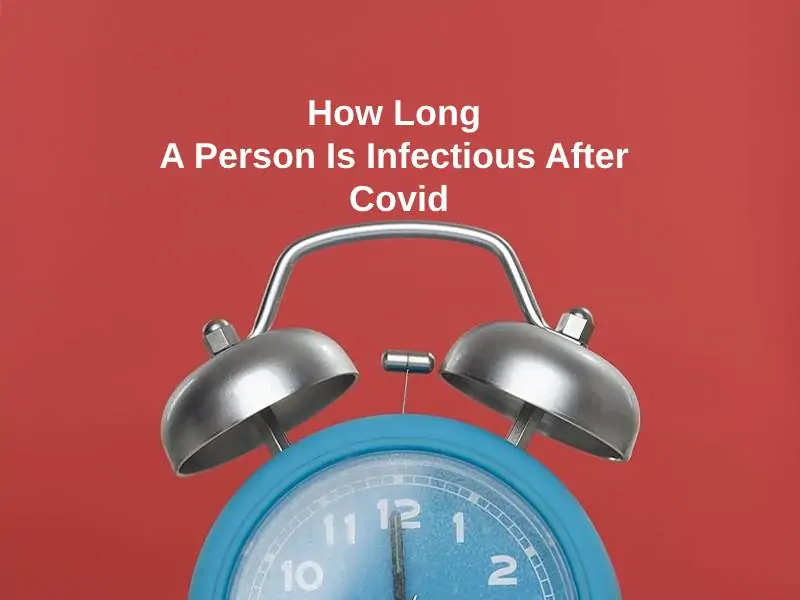Exact Answer: 2 to 10 days
As an extremely contagious form of viral infection, Covid-19 or SARS-CoV2 spreads through cross-contamination across groups of people. The rapid transmission of the virus has been accorded to its capability of infecting a large number of people within a minuscule time span.
Due to the highly infectious nature of the coronavirus, isolation is a necessary precautionary measure stated by global healthcare advisory boards. The mandated quarantine protocols are deemed essential to break the chain of infections around the world. Using face masks and observing social distancing are the other ways of avoiding infection and curbing the modes of transmitting the virus.

How Long Is A Person Infectious After Covid?
The time period between contracting a pathogen and developing symptoms of the disease is commonly known as the incubation period. During this period the virus lies dormant in the host’s body. This can be anywhere between 2 to 14 days.
Research on the infectious nature of the Covid-19 virus suggests that a person who has contracted the virus will remain most contagious during the initial days of suffering from the ailment. The first 48 hours after contracting the Covid-19 virus are considered to be the most infectious for an individual.
After this initial period of time, the infectious strength of the virus is weakened a little. However, if the person is asymptomatic –as has been the case of several Covid patients- then it becomes difficult to institute the Covid protocols. This is because they are unaware of the infection and thus, do not self-isolate.
Studies on the contagious nature of the virus have also suggested that the infectious abilities of the strain are tamed almost completely after the first 10 days of the infection. Thus, a person suffering from the ailment will almost certainly become less dangerous to those around after the first 10 days.
The 10 days guideline applies from the day the symptoms first appear. The key is to wait for the symptoms to alleviate. Thus, once again it becomes problematic to ascertain the infectiousness of asymptomatic individuals. Some guidelines also suggest that if a person does not have a fever without taking any medication for 24-hours after 10 days of first showing symptoms, they are to be deemed safe to exit self-isolation.
In Summary:
| Parameters | Contagiousness |
| Most Infectious | First 48 hours after showing symptoms |
| Least Infectious | After 10 days of showing symptoms |
Why Does A Person Remain Infectious For So Long After Covid?
The 2 week quarantine period is prescribed for all who display symptoms of the Covid-19 virus or test positive as most researchers agree that the virus remains highly active during this period. Self-isolation is necessary during this period to help assuage the spread of the infection.
A person remains most infectious during the initial days of the infection. The viral load during this time is quite high as the body is still attempting to devise a strategy to fight the pathogen. Thus, during the first 48 hours, the person remains highly contagious.
Alternatively, if the person continues to display symptoms like sneezing and coughing, the possibility of spreading the infection remains quite high. These are all modalities of transmitting the infection to others. In such cases, one must wait for these symptoms to resolve before ending the quarantine period.
After the first 10 days of showing symptoms, the viral load in a person’s body reduces. However, this must be accompanied by a simultaneous reduction or complete absence of the symptoms of the disease. Only in such cases the person is no longer deemed contagious.
However, despite these given protocols and guidelines, scientists believe that the actual time frame of the infectious nature of the virus cannot be definitively determined. As there are multiple mutant strains of the virus and each individual’s body chemistry is different from the other, there is no given way of asserting a proven and deterministic time frame for the annihilation of the infectious qualities of the virus.
Conclusion
Covid-19 is an extremely contagious form of coronavirus. The highly contagious nature of the virus has wreaked havoc in the global community. As scientists try to find a definitive cure for the virus, they have made some progress with regard to answering the multiple questions in the minds of people around the world.
Studies suggest that a person remains infectious after Covid for up to 10 days. The first two days remain crucial as the onset of symptoms makes the individual very contagious. Alternatively, after the initial 10 days of suffering from the ailment, the individual’s viral load reduces making him less infectious.